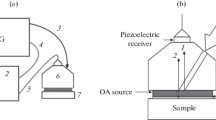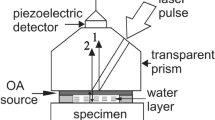An acoustic method for a quantitative assessment of the volume content of a polymeric matrix in CFRPs is proposed and realized experimentally. For this purpose, a laser-ultrasonic method based on the thermo-optical excitation of broadband pulses of longitudinal acoustic waves is used. A formula for calculating the volume content of the polymeric matrix in a CFRP from experimentally measured phase velocities of longitudinal acoustic waves in this material is proposed. Distributions of the volume content of the matrix in a control CFRP specimen and in a CFRP structure made under similar conditions are obtained. It is shown that the laser-ultrasonic method allows one to detect the areas with excess and deficient matrix content in CFRP specimens and areas of CFRP constructions and to quantitatively assess the spread of matrix content. The spread between the maximum and minimum matrix content observed depends on the shape of the investigated area of the structure. This method can be used for the quality control of composite structures before their exploitation.





Similar content being viewed by others
References
Ying Tie, Xi-Hui Zhou, Cheng Li, and Zhi-Zong Tian, “Effect of hole machining method on the behavior of CFRP laminates under low-velocity impacts,” Mech. Compos. Mater., 54, No. 3, 369-378 (2018).
M. R. Kumar, A. Ghosh, and D. Karuppannan, “Numerical and experimental characterization of a composite secondary bonded adhesive lap joint using the ultrasonics method,” Mech. Compos. Mater, 54, No. 2, 257-268 (2018).
O. V. Bashkov, A. E. Protsenko, A. A. Bryanskii, and R. V. Romashko, “Diagnostics of polymer composite materials and analysis of their production technology by using the method of acoustic emission,” Mech. Compos. Mater., - 53, No. 4, 533-540 (2017).
J. Varna and H. Zrida, “Analysis of microdamage on thermally aged CF/polyimide laminates,” Mech. Compos. Mater., 53, No. 1, 45-58 (2017).
V. Strizhius, “Fatigue damage accumulation under quasi-random loading of composite airframe elements,” Mech. Compos. Mater., 52, No. 4, 455-468 (2016).
V. Gribniak, A. K. Arnautov, A. Norkus, V. Tamulenas, E. Gudonis, and A. Sokolov, “Experimental investigation of the capacity of steel fibers to ensure the structural integrity of reinforced concrete specimens coated with CFRP sheets,” Mech. Compos. Mater., 52, No. 3, 401-410 (2016).
J. Lubin, Handbook of Composite Materials [Russian translation], M., Mashinostroenie (1988).
Yu. M. Tarnopol’skii, I. G. Zhigun, and V. A. Polyakov, 3D-Reinforced Composite Materials: Handbook [in Russian], M., Mashinostroenie (1987).
R. D. Adams and P. Cawle, “A review of defect types and nondestructive testing techniques for composites and bonded joints,” NDT Int., 21, No. 4, 208-222 (1988).
A. Benammar, R. Drai, and A. Guessoum, “Detection of delamination defects in CFRP materials using ultrasonic signal processing,” Ultrasonics, 48, 731-738 (2008).
M. Rouge and C. Leckey, “Characterization of impact damage in composite laminates using guided wavefield imaging and local wavenumber domain analysis,” Ultrasonics, 53, 1217-1226 (2013).
M. Kenane, Z. Azari, S. Benmedakhene, and M. L. Benzeggagh , “Experimental development of fatigue delamination threshold criterion ,” Composites: Part B, 42, 367-375 (2011).
A. M. Rubin and K. L. Jerina, “Evaluation of porosity in composite aircraft structures,” Compos. Eng., 3, Nos. 7-8, 603-618 (1993).
A. Zhang, H. Lu, and D. Zhang, “Effects of voids on residual tensile strength after impact on hydrothermal conditional CFRP laminates,” Compos. Struct., 95, 322-327 (2013).
M. Saeedifar, M. Fotouhi, M. A. Najafabadi, H. H. Toudeshky, and G. Minak, “Prediction of quasi-static delamination onset and growth in laminated composites by acoustic emission,” Composites: Part B, 85, 113-122 (2016).
A. A. Karabutov, N. B. Podymova, and I. O. Belyaev, “Investigation of the porosity on the attenuation of ultrasound in CFRP composites by the method of laser-ultrasonic spectroscopy,” Akust. Zhurn., 59, No. 6, 714-721 (2013).
N. B. Podymova and A. A. Karabutov, “Combined effects of reinforcement fraction and porosity on ultrasonic velocity in SiC particulate aluminum alloy matrix composites,” Composites: Part B, 113, 138-143 (2017).
V. E. Gusev and A. A. Karabutov, Laser Optoacoustic [in Russian], M., Nauka (1991).
N. B. Podymova, A. A. Karabutov, L. I. Kobeleva, and T. A. Chernyshova, “Quantitative evaluation of the effect of porosity on the local Young’s modulus of isotropic composites by using the laser optoacoustic method,” Mech. Compos. Mater., 49, No. 4, 411-420 (2013).
Yu. G. Sokolovskaya and A. A. Karabutov, “Lazerno-ultrazvukovaja defectoscopeия structures from multiaxial polymeric composite materials,” Konstr. Kompoz. Materials, No. 1, 56-61 (2018).
A. A. Karabutov, I. M. Kershtein, I. M. Pelivanov, and N. B. Podymova, “Rasprostranenie of longitudinal and shear acoustic videopulses in графито-эпоксидных composites,” Akust. Zhurn., 45, No. 1, 86-91 (1999).
N. B. Podymova, A. A. Karabutov, L. I. Kobelev, and T. A. Tchernyshov, “Lazernyj a optoacoustic method of measurement of local porosity дисперсно-filled metal-matrix composite materials,” Perspekt. Mаterialy, No. 3, 81-87 (2013).
M. M. Grigoryev, D. I. Kogan, O. N. Tverdaya, and N. N. Panin, “Features of manufacturing PCMs by the RFI method,” Elektron. Nauch. Zhurn., Trudy VIAM, No. 4, 3-11 (2013). URL: http://viam-works.ru/ru/articles?art_id=23 (date of reference: 01.03.2019)
M. I. Dushin, K. I. Donetsk, and R. Yu. Karavaev, “Establishing reasons for the formation of porosity in the manufacture of PCMs,” Elektron. Nauch. Zhurn., Trudy VIAM, No. 6, 68-78 (2016). URL: http://viam-works.ru/ru/articles?art_id=972 (date of reference: 01.03.2019)
S. M. Zharkii, A. A. Karabutov, I. M. Pelivanov, N. B. Podymova, and V. Yu. Timoshenko, “Research into the layers of porous silicon by the laser ultrasonic method,” FTP, 37, iss. 4, 485-489 (2003).
E. Oromiehie, B. G. Prusty, P. Compston, and G. Rajan, “ Characterization of process-induced defects in automation fiber placement manufacturing of composites using fiber Bragg grating sensors,” Structural Health Monitoring, 17, No. 1, 108-117 (2017).
Author information
Authors and Affiliations
Corresponding author
Additional information
Translated from Mekhanika Kompozitnykh Materialov, Vol. 56, No. 2, pp. 279-292, March-April, 2020.
Rights and permissions
About this article
Cite this article
Sokolovskaya, Y.G., Zharinov, A.N., Karabutov, A.A. et al. Determinating the Volume Content of a Polymeric Matrix in CFRP Structures Using a Laser-Ultrasonic Method. Mech Compos Mater 56, 185–194 (2020). https://doi.org/10.1007/s11029-020-09871-9
Received:
Revised:
Published:
Issue Date:
DOI: https://doi.org/10.1007/s11029-020-09871-9




